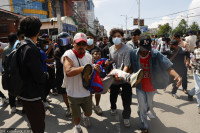Opinion
Caution, containment and continued care
Post-disaster epidemic outbreaks can be contained if we intervene now
Sameer M Dixit
Nepal has recently been affected by a devastating earthquake measuring 7.8 on theRichter scale(although this number varies between agencies), which has led to infrastructural damage and loss of life. Many who have survived the earthquake, especially in the villages around the epicentre, have now been camping out on open grounds for over 10 days.
History tells us that whenever natural (or other) disasters hit and people are forced out into the open for a long period of time, infectious disease outbreaks can occur.
The 2010 Haiti earthquake—measuring 7 on the Richterscale— killed many outright, but the ensuing cholera epidemic killed over 4,000 people. Years before that, during the Rwanda refugee crisis in 1994, an estimated 45,000 people died from a cholera epidemic. The 2005 earthquake in Pakistan led to a jaundice outbreak caused by the Hepatitis virus in over 1,200 people. These and other incidences show that disasters and diseases are linked.
There are a number of factors that might lead to the spread of diseases in post-disaster situations.
The most important one has to do with hygiene and sanitation as a result of crowding. Measles and rubella outbreaks have occurred in disasters elsewhere, where crowding has occurred in the aftermath of disasters. Similarly meningitis has been transmitted among those residing in crowded areas in post-disaster shelters.Zoonotic diseases, such as the rodent-caused Leptospirosis, or Acute Respiratory Infections that affect weakened lungs in children, are some of the other diseases that have been observed in various post-disaster situations as a result of crowding. There is no doubt that the lack of proper hygiene and sanitation plays a crucial role in the transmission of diseases in such situations. Open defecation, for example, allows harmful bacteria, viruses and parasites to get into the human digestive system. Similarly, in hot, humid conditions, open water-systems near settlements can lead to vector-borne diseases such as malaria and dengue, which can lead to long- term complications for those infected.
But there are interventions that can be taken to prevent such outbreaks. Open storage systems for water that has collected as a result of rain, or used as reservoirs, should be discouraged. Such reservoirs should be treated to ensure that insects such as mosquitoes do not lay eggs in them. Similarly, not washing hands with soap and water after toilet visits and not havingseparate enclosed toilets are examples of bad hygiene and sanitation practices. In crowded camps that do not have toilets in the vicinity, a simple trench system can be built that empties into a larger closed trench. Temporary enclosures made of bamboo and tarpaulins can be built above the trench to ensure privacy. Once the temporary settlement is no longer required, such trenches can be disinfected and covered with soil. This arrangement has been successfully used in many quake-affected villages around the world.
Disease outbreaks in post-disaster settings can also have drinking water and food as their source. To prevent the spread of pathogens, food must be properly cooked, and the consuming of factory-sealed dry food items must be encouraged. In the case of water, drinking only boiled (and cooled as necessary) and/or chlorine-treated water is a sure way of preventing waterborne pathogen infection. High temperature kills most germs, whether viruses or bacteria, as does treating the water with chlorine. Potassium is also sometimes used to treat water. Examples of water and food borne diseases are diarrhoeal diseases (including but not limited to cholera and dysentery) and viral hepatitis (caused by the Hepatitis A & E virus).
Diseases can also be caused as a result of weakened human immune systems brought about by mental exhaustion in post-disaster settings. The human immune system is in a state of controlled chaos—meaning that although multiple interactions are ongoing inside our body in normal situations, we remain healthy because those interactions are balanced. This includes the control of germs that naturally live inside our body. However, stress can cause major new events inside our body, and as a result, they can lower our immune-response capacity, thus making us more vulnerable to minor infections. This in turn, allows harmful but otherwise dormant germs to suddenly become active and start attacking our body (in what is known as opportunistic infection) and our weak immune system is unable to fight the infection. Although this is a temporary event, it can nonetheless cause diseases.
The solution to these problems is proper counselling. There is no doubt that in light of the current disaster here, not only children but many older members of the community are frightened, largely due to thelack of reliable information. Thus, there is an urgent need to have counsellors visit the affected communities and counsel those that are most affected—the children and the elderly. This step will play a vital role in disease prevention and put the entire community at ease.
Post-disaster settings are fertile breeding grounds for harmful germs such as bacteria, viruses and parasites. If adequate measures are not put in place, minor infections can spread and engender an epidemic. Even in the most difficult situations, targeted interventions such as communications with the community can be ensured, preventive measures can be put in place and continuous surveillance can be undertaken. This requires the public to be self-aware and needs the government and stakeholders to come together to further support the community. Epidemics will not happen if simple measures are effectively pursued.
Sameer M Dixit, PhD. Director of Research (Public Health), Centre for Molecular Dynamics Nepal (CMDN)




 19.12°C Kathmandu
19.12°C Kathmandu








%20(1).jpg&w=300&height=200)

